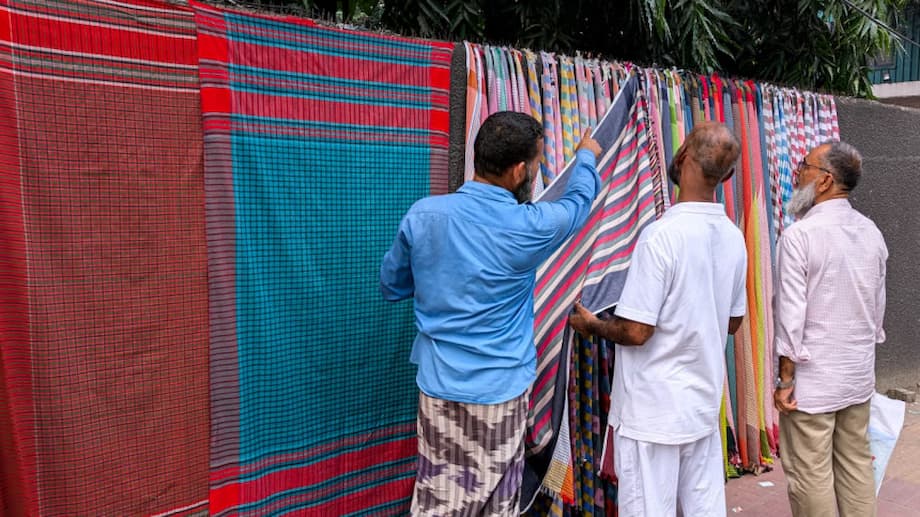A living canvas in the heart of Dhaka
On a stretch of Mirpur Road in Shyamoli, a burst of color cuts through the city’s grey. Cotton gamchas, the humble towels of Bangladesh, drape across concrete walls like a street gallery. Stripes and checks sway in the breeze, red and blue against green and gold, rows upon rows stitched to the city’s rhythm. This is the Shyamoli gamcha market, a compact open air bazaar that turns an ordinary sidewalk into a living canvas of color and craft.
The site is easy to find. It sits near SOS Shishupalli and faces Dhaka Shishu Hospital, where foot traffic never really stops. Stalls begin to open around 10 AM. Sellers arrange fresh stock, tidy the display, and ease into the day as buses groan past. They pack up by 10 or 11 PM, sometimes a little earlier if the weather turns. The pattern repeats daily, steady and practical, much like the cloth they sell.
To understand the scene, it helps to know the gamcha itself. It is a sturdy, breathable cotton cloth, used as a towel, scarf, sunshade, head wrap, or quick sling for carrying things. Farmers tie it around the head in the fields. Rickshaw pullers keep one handy to wipe sweat. At home, it serves as a towel or drying cloth. Lightweight and quick to wash, the gamcha mirrors the country’s resourceful, everyday culture. In Dhaka, that heritage usually hides behind concrete, glass, and traffic, yet here it sits in the open, bright and unmissable.
Where the colors come from
Every Saturday, new bundles arrive. Vans pull up with stacks of cotton from Sirajganj, a heartland of weaving, and from Baburhat in Narsingdi, a famous wholesale bazaar. Supplies also come from Kushtia’s Kumarkhali, Pabna, Jhalokathi, and Chapainawabganj. The mix keeps designs abundant and prices flexible. Sellers say there are three or four common types on display most days, from simple checks to broader stripes and single color towels.
Prices start low. A basic cotton gamcha can be found for about Tk 30 to Tk 50. Larger, thicker, or better finished pieces run between Tk 120 and Tk 200. Cotton towels known as tawal gamcha or towailla often sell around Tk 150. Many stalls also carry lungis from Kushtia, usually between Tk 250 and Tk 300, depending on weave and pattern. The market caters to both walk in shoppers and bulk buyers, which helps keep the selection fresh and the turnover brisk.
Md Rafiqul Islam, a seller in his mid fifties who offers both gamchas and lungis, described how he settled into the trade and stayed with it. He sat under a shade, watching the road, as he summed up his tenure.
“It has been 10 to 12 years since I started here.”
Another vendor, Md Shahadat Hossain, explained how output has changed as weaving moved from cottage setups to power looms. He contrasted the rhythm of a busy modern weaving shed with the patient pace of a handloom.
“Before, everything was handmade. In a whole day, only four or five gamchas could be made. Now, with machines, one person can produce 50 to 60 a day.”
The wall and the neighborhood
Locals call it the gamcha wall for a reason. The display climbs the roadside surface to about seven foot high, a patchwork that turns cracked concrete into a tapestry. Over time the color has spread, running along Mirpur Road and pushing into Shyamoli’s road number 4 near the Kallyanpur canal. What began as a few stalls now looks like a district landmark, easy for residents to describe and convenient for anyone passing through.
The surroundings shape the crowd. The area is dense with hospitals, clinics, and offices. Patients and families walk by all day. Students and young professionals from Shyamoli, Mohammadpur, and Kallyanpur cut across the stretch on foot. Many buy a couple of gamchas on impulse, attracted by the utility and the low price. Shopkeepers often purchase in bulk. So do tailors who turn gamcha cloth into fatuas (short kurtas), beach style wraps, or casual shirts, a trend that has lifted demand for brighter patterns and thicker weaves.
On the sellers’ side, the market is a source of steady, if modest, income. Vendors quoted daily earnings that range from roughly Tk 4,000 to Tk 7,000 on regular days, with some lift during holidays or festival seasons. One seller, Md Ruzel Mia, described why the stall matters for his household.
“The income from my little business is not much, but it has helped my family feel somewhat secure.”
Several vendors said they appreciate the low hassle nature of the spot. Payments from wholesalers are made through bank transfers and mobile financial services. Buyers pay in cash or mobile accounts, and there are not many extra hands to satisfy. The sellers also keep the walkway clean, sweeping up scraps and plastic so the public face of the market looks tidy. The color draws the eye, but the order keeps people coming back.
The people behind the stalls
The market grew from a handful of sellers to a recognized stop for cotton towels and related goods. The exact count shifts through the year, but accounts from the traders themselves tell a story of persistence and gradual expansion. One of the earliest voices is Momrez Ali, who remembers when the place barely registered on a city map of commerce.
“At that time, there were only two shops here.”
He dates his start to the early 2000s, a small bet that years later feels like a smart reading of what people in a busy neighborhood might want. Another trader, Abdur Rahim from Chapainawabganj, recounted his arrival at the site and how the roster of stalls has changed with time and season.
“I started selling gamchas here in 2012, a few years after the market began.”
Family history threads through the market too. Beside Bangladesh Specialized Hospital, Md Salahuddin carries on a craft that shaped his childhood. His family’s roots in weaving reach back to Chapainawabganj. The current business model looks different from the one his father and grandfather knew, yet the continuity remains.
“My father and grandfather were both gamcha makers in Chapainawabganj. Eventually, I learned the craft too. But these days, we only sell after collecting from the vendors.”
Depending on the month and the flow of buyers, you might see seven regular sellers operating on most days, or closer to a dozen when the weather is friendly and sales run high. The display changes as stock rotates. Color stories shift across the wall. In a city short on calm, the tableau feels both lively and reassuring.
Patterns, prices, and how to choose
Gamchas in Shyamoli span a simple range of looks and qualities. For quick purchases, a basic check or stripe in mid weight cotton will do the job as a towel or scarf. Those can sit near Tk 50 to Tk 120, depending on size and finish. For a gift, buyers reach for softer weaves and deeper color sets, which may run closer to Tk 150 to Tk 200. Towels labeled as tawal gamcha or towailla add softness and a bit more heft for home use, usually around Tk 150.
Patterns include single color fields, small checks, large checks, and stripe combinations that blend two or three tones. A bright red or bottle green stripe remains classic. Indigo and mustard mixes feel current, especially in summer. The stall layout helps comparisons. Sellers will often spread a few options side by side so you can see how the weave density and finish differ. Always run your fingers along the edge. A clean selvedge and neat stitching signal a better finish.
If you plan to buy in bulk for a sports team, a small shop, or a family event, tell the seller. Bulk buyers often secure a small discount and a mix of colors that fit a theme. Watch for colorfastness if you need bright towels for repeated wash cycles. Most of the products are 100 percent cotton, which makes them breathable and easy to care for. A gentle wash keeps color longer, and line drying protects the fabric from high heat.
From village staple to city style
The gamcha’s leap from village staple to urban fashion has helped the Shyamoli wall flourish. Tailors in nearby neighborhoods stitch the cloth into fatuas (short kurtas), airy tops, and casual wraps. Young shoppers throw a gamcha over the shoulder as a quick scarf on campus, or pack a bundle for a weekend river trip. One group of teenagers was recently seen buying 15 pieces for a boat ride to Moinot Ghat in Dohar, a small snapshot of how this rural textile fits modern city plans.
Designers and small brands have also experimented with gamcha as panels on shirts and bags. The fabric’s light weight, simple weave, and strong cultural identity make it ideal for casual wear. For many buyers, that mix of practicality and identity is the draw. You do not need to announce anything. The cloth does the talking.
Handmade roots, changing production
Behind the colors is a shift in how the cloth is made. Traditional handlooms still operate in pockets of Sirajganj and other districts, yet the bulk of Shyamoli’s stock now comes off power looms. Output has climbed from a few pieces per worker each day to dozens. That increase keeps prices accessible and supply consistent through the year. It also softens the seasonal pressures that used to shape production in villages.
The transition brings trade offs. Hand woven pieces often feel softer and show minor irregularities that many buyers love. Power loom fabric is more uniform, which suits bulk orders and tight delivery schedules. While that change helps sellers manage demand in Dhaka, it also raises questions about craft skills and how to keep them alive for the next generation.
At a recent craft event in Dhaka, Malobika Dipanwita Roy, a community architect who works with artisan groups, warned about losing skills over time. Her comment captures the wider challenge beyond any single market.
“This knowledge is fading. If we do not act now, we risk losing entire systems of traditional wisdom.”
Efforts to preserve craft do not have to freeze designs in place. Makers can keep a core identity and still experiment with new colors, sizes, and uses. The Shyamoli market shows a version of that balance each day, with classic checks sharing space with bold stripes, and towels sitting next to stitched clothing that did not exist in the same way a decade ago.
Who buys gamchas here and why it matters
The customer base is as mixed as the patterns on the wall. Hospital visitors grab towels for overnight stays. Office workers pick up two or three for home. Students choose bright colors for hostel life or day trips. Small retailers buy in bulk to stock neighborhood counters. Busy residents appreciate that the market spares them a long ride to a wholesale hub, and the prices rarely give a shock.
The market’s value goes beyond convenience. It connects urban buyers to rural weaving centers through a simple, affordable product. The cloth is cotton, easy to wash and reuse, and rolls small enough to carry all day. In a city where affordable essentials matter, the gamcha checks several boxes at once. It is practical, low waste, and deeply familiar. For many Dhaka residents, it is also nostalgic, a token of village life carried into the city.
The wall has turned an unremarkable sidewalk into a tidy open air market without walls or entry fees. Vendors keep the stretch clean and orderly. Passersby stop to ask about a color, then often stay for a chat. That rhythm, repeated through the day, is part of why the place feels welcoming. You see culture in motion, not in a glass case.
Planning a visit
Hours run from late morning to late evening. For the most choice, try Saturdays in the late afternoon, after new stock arrives and is sorted. Weekday evenings also work well, when office crowds thin and sellers have time to show a few more designs. If you want specific colors or sizes, say so. The vendors know their stock by memory and often pull the right bundle in seconds.
Carry small bills for quick buys and be ready to pay through mobile financial services if that is easier. Haggling is part of the exchange, though the baseline prices are already low. For luggage or bulk orders, ask for a sack and tie. If you plan to walk across the area, watch the curb and the traffic flow. The display hugs the wall, leaving enough room for pedestrians, yet peak hours can still feel cramped.
Many buyers pick up a few extras for friends or family. The cloth makes a practical gift, easy to pack and easy to wash. If you are buying for a team or event, choose three colors that work together, for example red, blue, and white checks, or two tone stripes with a neutral. The results look good in photos and are simpler to sort later.
Key Points
- Shyamoli’s gamcha wall sits along Mirpur Road near SOS Shishupalli, across from Dhaka Shishu Hospital.
- Stalls open around 10 AM and close by 10 or 11 PM, with fresh stock arriving on Saturdays.
- Supplies come from Sirajganj, Narsingdi’s Baburhat, Kushtia’s Kumarkhali, Pabna, Jhalokathi, and Chapainawabganj.
- Basic gamchas start around Tk 30 to Tk 50, higher quality pieces run up to about Tk 200, and cotton towels are often near Tk 150.
- Most products are cotton, with patterns across single color, checks, and stripes, suited for both home and fashion use.
- Vendors report daily earnings near Tk 4,000 to Tk 7,000 and a smooth payment process through banks and mobile services.
- Shoppers include hospital visitors, students, office workers, and bulk buyers such as tailors and small retailers.
- Production has shifted toward power looms, boosting output while raising concerns about preserving hand weaving skills.
- The market has grown from a few stalls to a recognized local fixture, offering a colorful and tidy public space.




